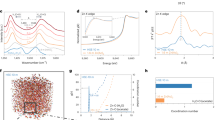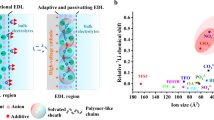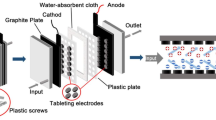Abstract
THERE are two interesting aspects of the distribution of a direct current flowing between soluble metal electrodes in an aqueous electrolyte confined in an insulating vessel. Theoretically the problem appears to be soluble, ideally at least, by classical potential theory using the electrochemical theory of the anode and cathode fall. The distribution is of great practical importance in attaining uniform deposits on curved surfaces and in holes, and in avoiding heavy deposits on sharp edges and projections.
This is a preview of subscription content, access via your institution
Access options
Subscribe to this journal
Receive 51 print issues and online access
$199.00 per year
only $3.90 per issue
Buy this article
- Purchase on SpringerLink
- Instant access to full article PDF
Prices may be subject to local taxes which are calculated during checkout
Similar content being viewed by others
References
Gardam, G. E., Trans. Far. Soc., 34, 698 (1938).
Haring, H. E., and Blum, W., Trans. Amer. Electrochem. Soc., 44, 313 (1923).
Field, S., and Weill, A. D., "Electro-Plating" (London, 1938).
Kasper, C., Amer. Electrochem. Soc., 77, preprint 28 (April 1940).
Ollendorff, F., "Potentialfelder der Elektrotechnik" (Berlin: Springer, 1932).
Author information
Authors and Affiliations
Rights and permissions
About this article
Cite this article
ENGEL, A. Current Distribution and Throwing Power in Electrolytes. Nature 146, 66 (1940). https://doi.org/10.1038/146066a0
Published:
Issue date:
DOI: https://doi.org/10.1038/146066a0



